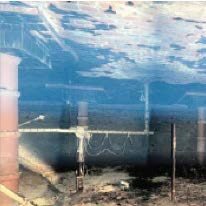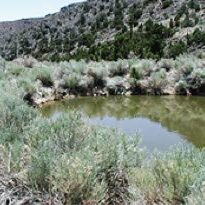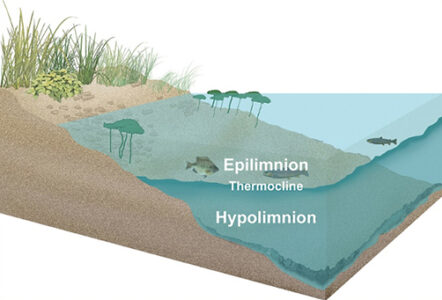Identifying biogeochemical processes that control metal and radionuclide cycling in the environment
Project website | Overview brochure PDF
- Principal investigator: Mavrik Zavarin
Technical co-manager: Annie Kersting - Annual report: 2023 | 2021 | 2019 | 2017 | 2016 (Note: Reports are not issued during SFA review years.)
Interfaces are defined as the thin layer located between two phases of matter, each of which may be solid, liquid, or gas. The two phases have distinct properties, leading to strong biogeochemical gradients that are focused at the interface and drive a multitude of reactions. Interfaces span across all scales of Earth systems, including mineral-water interfaces at the molecular scale, microbe-mineral and microbe-water interfaces at the micrometer scale, terrestrial-aquatic interfaces at the watershed scale (e.g., encompassing rivers, lakes, and wetlands), and land-ocean coastal interfaces at the continental scale.

Investigating Multiscale Processes. Lawrence Livermore National Laboratory’s Science Focus Area investigates biogeochemistry at interfaces from the nanometer scale in the laboratory to the meter scale in the field to identify the dominant biogeochemical processes and underlying mechanisms that control metal and radionuclide mobilization in surface water and groundwater.
Reliable predictions of metal and radionuclide cycling and migration in surface waters and the subsurface are limited by our knowledge of key processes controlling biogeochemical reactions at interfaces. The BioGeoChemistry at Interfaces Science Focus Area (SFA) led by Lawrence Livermore National Laboratory (LLNL) is addressing this challenge. By identifying the dominant biogeochemical processes and underlying mechanisms that control metal and radionuclide mobilization in surface water and groundwater, this SFA is advancing efforts to reliably predict their cycling and mobility in the environment. The project is supported by the Department of Energy’s (DOE) Office of Biological and Environmental Research (BER), within DOE’s Office of Science, as part of BER’s Environmental System Science (ESS) program.
Key Knowledge Gaps
The LLNL SFA is focused on advancing our understanding of surface and subsurface processes that control transport and cycling of redox-sensitive metals and radionuclides with a particular focus on reactions at environmental interfaces.
Key knowledge gaps addressed by the LLNL SFA include:
- Factors affecting long-term stabilization of metals and radionuclides at mineral-water and sediment-water interfaces.
- Metal and radionuclide incorporation into secondary mineral phases.
- Metal and radionuclide stabilization on surfaces when coupled to transient redox cycles.
- Role of microbes and their exudates in metal and radionuclide mobilization and stabilization on microbe and mineral surfaces.
Hydrologically Diverse Field Sites




Hydrologically Diverse Field Sites. The four SFA field sites enable testing of specific processes that influence the long-term evolution of metal and radionuclide mobility in the environment. Field sites include a vadose zone waste site (Hanford Site), perched water drainage ponds from a nuclear testing site (Nevada National Security Site [NNSS]), reactor cooling ponds linked to the Savannah River Site (SRS), and an estuary (Ravenglass) located near a reprocessing facility (Sellafield, U.K.). These sites were chosen based on their known variations in contamination history, location within the watershed, and biogeochemical processes believed to control metal and radionuclide cycling.
Linking Laboratory Experiments, Modeling, and Field Observations

Reaction chemistry at stratified pond interfaces. In lakes and ponds such as those at the Savannah River Site (SRS), the density difference between warm surface waters and cold bottom waters in the summer leads to two distinct layers of water. This phenomenon, called stratification, prevents whole lake mixing. The upper pond layer (epilimnion) remains well oxygenated (oxic) while the bottom layer (hypolimnion) is oxygen depleted (anoxic). The pond sediments are often anoxic as well. The complex biological and geochemical redox chemistry across these interfaces controls metal and radionuclide cycling in these lakes and ponds.
Predicting long-term behavior in the environment necessitates an approach that integrates research across multiple scales, linking laboratory experiments and computational models with field observations.
Laboratory experiments provide quantitative data on the affinities, kinetics, and morphology of reactions at interfaces (mineral surfaces, organic matter, and microbes). Field observations provide direct evidence for long-term behavior in the environment as well as a foundation for a conceptual understanding of metal and radionuclide cycling and migration.
This integrated laboratory, modeling, and field observation approach is being used to quantify metal and radionuclide transport at four unique contaminated sites: the Nevada National Security Site (NNSS), Hanford Site (Richland, Washington), Savannah River Site (SRS; Aiken, South Carolina), and Ravenglass site (Sellafield, U.K.). Field studies capture radionuclide behavior on the timescale of decades. The diverse range of conditions at these four sites provides an opportunity to expand current conceptual understanding of radionuclide migration within specific components of a watershed system and link it to other metal cycling processes in these systems (e.g., iron cycling). Fundamental laboratory studies are used to isolate specific biogeochemical processes and mechanisms that are observed in the field and impact long-term fate and transport. These processes include mineral co-precipitation, the role of redox cycling, and the role of microorganisms in mobilization and immobilization of metals and radionuclides.
Research Across Multiple Scales
The BioGeoChemistry at Interfaces SFA is building an understanding of long-term metal and radionuclide migration behavior in the environment. Findings from both field and laboratory studies identify key processes across spatial and temporal scales that are used to develop conceptual and numerical models and improve prediction of metal and radionuclide cycling and migration in the environment.

